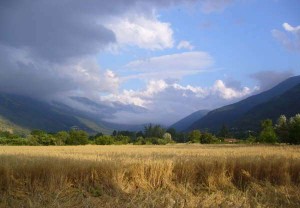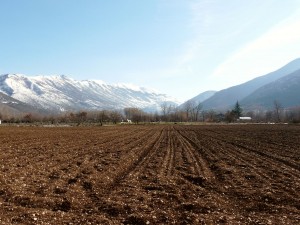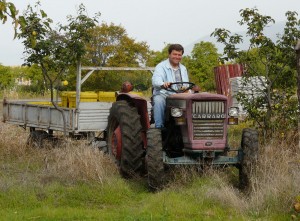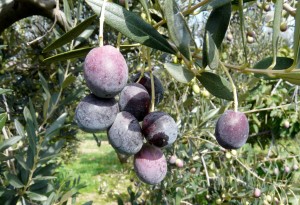Stuart Haines shares the story of two brothers who returned to their native Abruzzo in order to reclaim their ancestral life, farming garlic & olives…

The cost of milling a hundred kilos of olives goes up every year; every year a euro or two more!” Luca is explaining the realities of trying to make a living as an olive grower. “And there are only three mills left in the valley. When my father worked these fields there were many more.”
Franco, his elder brother, adds: “It’s been a tough year. Some people say there is hardly an olive in their grove. They’re not even going to harvest. But we, at least, will get a crop – our small gentile trees have survived better than other varieties.”
2012 was a remarkable year. In February a metre of snow fell in one day and stayed for three weeks. The roof of the sports hall collapsed under the weight. By Easter the land was warming, and blossoms were on the trees. But, in May, a late frost nipped most of those little flowers right off. No flowers, no olives. And still it wasn’t done – two weeks later the last soaking rain fell for almost three months. The hottest summer Luca could remember. Olives can tolerate harshness, but there was no water on the valley slopes and even an olive tree needs an occasional drink.

Olives have been cultivated in the Gizio valley, south of Sulmona in the heart of Abruzzo, for more than two thousand years. It is a tradition and a way of life for people here, with some trees said to be hundreds of years old. But it’s harder and harder to make it pay and this way of life is being followed by a diminishing number of families. When you add the huge competition from the industrial producers to the unpredictability of the seasons, you begin to see why.
I’ve known Franco and Luca for several years. Their father, Filipo, sold me my own vineyard in Italy. Franco and Luca, like Filipo, were born in the valley, just an olive stone throw from where Franco now lives on their small farm. Gianna, Franco’s mother, lives next door. The 20 years after the war were tough in rural Italy, especially so in Abruzzo and the regions further south. Filipo and Gianna decided that there was a better life for them and their young boys in North America and, in the early 1960s, they locked up the house, left the fields and went to New York.
But their roots remained in the fields. Though Franco and Luca became young Americans – learnt English, went to college, started careers – they could not shake themselves free of the old ways that generations of their family had followed in the valley. So in the 1980s they returned to open up the house, determined to pursue the life they had never really known but was their inheritance.

They were to learn that olives only grow well on the slopes of the valley. The flat and fertile valley bottom is, however, well suited to other crops. The brothers’ farm spreads over ten hectares – a patchwork of fields around the house. Some of the land is apple orchards, vineyards and a small walnut grove but the biggest fields are rotated every three years between barley or beans, lying fallow and garlic.
The city of Sulmona is famous for garlic production. In fact, it even boats its own variety – Aglio Rosso di Sulmona – considered by garlic lovers to be top of the crops. Its flavour is second to none. The rich soil, favourable climate and lots of hard work are the perfect ingredients to create a good yield. Compared to the return on barley and beans, which for a small producer is virtually nothing, a few hectares of good quality garlic means the farm can stay in business for another year.
The garlic cycle begins in October when Franco, who being the big brother always drives, takes the old tractor to plough over the chosen fields. Back in the shed the stacks of seed bulbs are broken up, preferably by hand, into cloves for planting. The first week in November is planting time. Judging the moment is crucial – too soon and you risk early sprouting, too late and you risk frost. And if it rains then the tractor will churn up the ground. Once the frantic few days are over and tens of thousands of cloves are safely sown, it’s off to harvest the olives.
The cloves lie dormant through the winter, waiting for the first warmth. When 50,000 new shoots push through the surface, spring is around the corner! While the fresh plants grow taller it’s back to the olives to prune and prepare for blossom time. It’s here that the brothers pray the weather stays kind as the tiny plants establish themselves; never a moment when they’re not thinking about weather.
In May it’s time to weed – back-breaking labour to pull unwanted growth from around the rising stems, uprooting the competition for nutrients and light. It’s a two week-long toil with no alternative. A machine is too harsh – the hours spent now will bring rewards later.
Early June is the time to pull the growing shoot, the zolla, from every bulb swelling beneath the surface. This encourages it to fatten, boosting quality and yield. But zolla themselves are prized. They are the most delicious salad or frittata ingredient, boasting a powerful taste.
June is hot and the fields need irrigating to keep the bulbs thriving. Water channelled from the Gizio river is flooded across the ground for a half day. The plants are knee high, stray poppy heads punctuate the bluey-green sea and, when the breeze stirs, the smell is fantastic.
One morning in July, the brothers walk into the field and agree that tomorrow is the day the harvest begins. For days the old tractor – piled high with plants prised from the soil, the beautiful white bulbs exposed for the first time – chugs between fields and shed.
 The harvest is in but now the brothers face possibly the hardest step: preparation for market. For years, the family plaited the drying plants into beautiful braids – a skilled and time-consuming process. Sadly though it is not worth the effort as a plait of 25 bulbs fetches just €15 in Sulmona market. The wholesaler from Pescara takes only cleaned, de-bearded and trimmed bulbs. The two month task begins beneath a small shelter to shade the fierce summer sun. Finally the last bulb is placed into the last crate – the wholesaler arrives, loads up, pays up and is gone leaving the hooded crows to pick over the fields.
The harvest is in but now the brothers face possibly the hardest step: preparation for market. For years, the family plaited the drying plants into beautiful braids – a skilled and time-consuming process. Sadly though it is not worth the effort as a plait of 25 bulbs fetches just €15 in Sulmona market. The wholesaler from Pescara takes only cleaned, de-bearded and trimmed bulbs. The two month task begins beneath a small shelter to shade the fierce summer sun. Finally the last bulb is placed into the last crate – the wholesaler arrives, loads up, pays up and is gone leaving the hooded crows to pick over the fields.
“50 cents a kilo more than last year,” says Luca. He seems happy enough but a little regretful too. The family will make enough from the crop and from their high quality olive oil to ensure the cycle begins again. It’s a small and precarious living producing food of the highest quality in the traditional way – slow, sustainable, wonderful.
I listen to their tractor clatter along the lane and wonder why they do it. It makes no sense but, actually, it makes every sense to me. Their lives are in the valley, and their ancestors did the same – they are, in a way, as much a part of the soil as the ancient olive trees. Every year it gets a little harder, but they know they will never give it up.
WHERE TO EAT
➤ Ristorante Il Torchio
Piazza Zannelli 2,
Pettorano sul Gizio
+39 086 448 541
Closed Tuesdays.
Wonderful family-run restaurant and pizzeria tucked into the corner of beautiful Piazza Zannelli in the centre of ancient Pettorano Sul Gizio. The best in the valley, specialising in local dishes and featuring an excellent and affordable wine list.
➤ Pizzeria Napoletana
Viale Mazzini 39, Sulmona
+39 086 451 710
Really good traditional pizzeria just out of the centre of Sulmona on the way to Pettorano; just wood-fired pizzas and cold beer and excellent at both. Open every day. Quite small and very popular but they’ll fit you in if they can.
WHERE TO STAY
➤ Hotel Rojan
Via Degli Agghiacciati 15, Sulmona
+39 0864 950 126
This much admired family run hotel is located in the old centre of Sulmona. Four stars and medium price range; a great location and a very comfortable base.
➤ Casa La Rocca
Contrada Case La Rocca 10,
Pettorano sul Gizio
If you’re looking to self-cater, the apartment at Casa La Rocca sleeps four in a double and a twin room. The apartment lies in the Valle del Gizio – 4km from Sulmona and 5km from Pettorano. It is surrounded by fields and has wonderful views.
GETTING THERE
➤ BY ROAD
Sulmona is two hours from Rome by car on the A24 and then A25 motorways. From the Adriatic coast, it is an hour from Pescara on the A25. The town is about 10km from the motorway exit. Express coaches link Sulmona to Rome, Pescara, Naples and Bologna – about five times a day to each of these places.
➤ BY PLNE
Fly into Rome or Pescara with several budget airlines from many UK cities.
➤ BY TRAIN
Sulmona can also be reached by train several times a day from Rome and from Pescara. The journey times are longer but the ride is very pretty.
